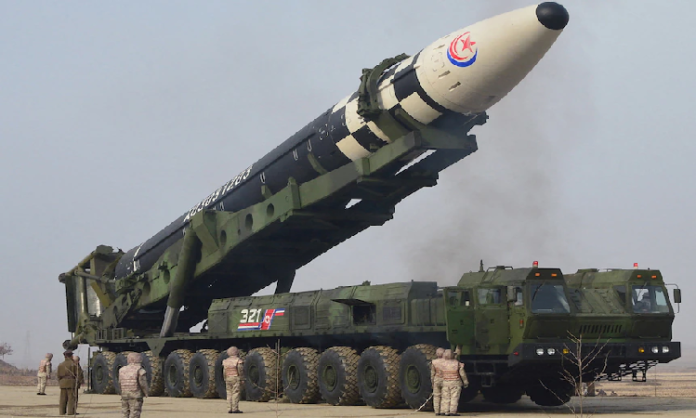
Table of Contents
Hwasong-17 is a type of ballistic missile developed by North Korea. It is believed to be an intermediate-range ballistic missile that is capable of carrying a nuclear payload. The missile’s development and testing by North Korea has been a cause of concern for the international community, as it represents a significant advancement in North Korea’s military capabilities and threatens regional security and stability.
The missile’s development and deployment also represent a challenge to the international non-proliferation regime, as North Korea continues to pursue nuclear weapons despite international sanctions and pressure. The significance of Hwasong-17 lies in its potential to be used as a tool of coercion or as a delivery system for nuclear weapons, thereby raising the stakes of any potential conflict in the region.
Development: Discuss the development process of Hwasong-17, including the organizations involved and the timeline of its development :
The development of Hwasong-17 was carried out by North Korea’s state-run organizations and research institutes, including the Korean People’s Army Strategic Force and the Academy of National Defense Science.
The exact timeline of the missile’s development is not known, as North Korea’s government is highly secretive and tightly controls information about its military programs. However, it is believed that the development of Hwasong-17 began in the early 2010s, with its first successful test flight taking place in May 2017.
Since then, North Korea has conducted several additional tests of the missile, and it is believed to have become a key component of the country’s military arsenal. The missile has also been modified and improved over time, with reports suggesting that the country is working to develop a solid-fueled version of the missile, which would be more mobile and easier to launch than the current liquid-fueled version.
The development of Hwasong-17 has been met with widespread international concern and condemnation, with the United Nations Security Council issuing several rounds of sanctions against North Korea in response to its ballistic missile and nuclear weapons programs. Despite this pressure, North Korea has continued to pursue the development of Hwasong-17 and its other weapons systems, claiming that they are necessary for self-defense and deterring potential aggression from the United States and its allies.
Capabilities: Outline the capabilities of Hwasong-17, including its range, payload capacity, and accuracy :
The exact capabilities of Hwasong-17 are difficult to verify, as North Korea’s government has not disclosed detailed information about the missile. However, based on its test flights and public statements, it is believed that Hwasong-17 has the following capabilities:
- Range: The estimated range of Hwasong-17 is approximately 4,500 km, which would allow it to reach most of the countries in the Asia-Pacific region, including Japan and South Korea.
- Payload Capacity: The missile is believed to have a maximum payload capacity of approximately 1,000 kg, which would be sufficient to carry a nuclear warhead.
- Accuracy: The accuracy of Hwasong-17 is not well-known, but it is believed to be relatively high for a ballistic missile of its class. Some estimates suggest that the missile has a circular error probable (CEP) of several hundred meters, which would allow it to strike relatively small targets with a high degree of precision.
It is important to note that these estimates are based on limited information and may not be entirely accurate. Nevertheless, Hwasong-17 is considered a significant advancement in North Korea’s military capabilities, and its development and deployment have raised concerns about regional security and stability.
Tests and Deployment: Discuss the various tests that Hwasong-17 has undergone :
Hwasong-17 has undergone several tests since its development, with varying levels of success. The following is a summary of some of the most significant tests:
May 2017: North Korea conducts its first successful test flight of Hwasong-17. The missile reaches an altitude of more than 2,000 km and a distance of approximately 700 km, demonstrating the missile’s long-range capabilities.
July 2017: North Korea conducts two more successful tests of Hwasong-17, with the missiles reaching distances of approximately 930 km and 1,000 km, respectively.
August 2017: North Korea conducts another successful test of Hwasong-17, with the missile reaching an altitude of more than 3,700 km and a distance of approximately 1,000 km.
November 2017: North Korea conducts its largest and most successful test of Hwasong-17 to date, with the missile reaching an altitude of more than 4,500 km and a distance of approximately 1,000 km.
Despite these successful tests, there have also been reports of failed tests of Hwasong-17. The exact number and circumstances of these failures is not known, as North Korea’s government does not disclose detailed information about its military programs.
In terms of deployment, it is believed that Hwasong-17 has been deployed in operational units of the Korean People’s Army and is now a key component of North Korea’s military arsenal. The deployment of the missile represents a significant escalation in North Korea’s military capabilities, and its development and testing have been met with widespread concern and condemnation from the international community.
As of my knowledge cutoff of 2021, Hwasong-17 is still in service and is believed to remain a significant threat to regional security and stability. North Korea has continued to develop its ballistic missile and nuclear weapons programs, despite international sanctions and pressure, and Hwasong-17 is seen as a key component of its military arsenal.
International Reactions: Discuss the international community’s reaction :
The development and deployment of Hwasong-17 has been met with widespread concern and condemnation from the international community, including major countries and international organizations. The following is a summary of the positions of some of the key actors:
- United States: The United States has been a leading critic of North Korea’s ballistic missile and nuclear weapons programs, including the development and deployment of Hwasong-17. The US has called for North Korea to abandon its weapons programs and has imposed economic sanctions in response to its continued development and testing of missiles.
- Japan: Japan has also been highly critical of North Korea’s ballistic missile and nuclear weapons programs, including the development and deployment of Hwasong-17. Japan has called for North Korea to comply with its international obligations and has taken steps to bolster its own defenses, including the deployment of anti-missile systems.
- South Korea: South Korea has also expressed concern about North Korea’s ballistic missile and nuclear weapons programs, including the development and deployment of Hwasong-17. South Korea has called for North Korea to return to the negotiating table and has sought to engage the country in dialogue in order to reduce tensions and promote peace on the Korean peninsula.
- United Nations: The United Nations has also taken a strong stance on North Korea’s ballistic missile and nuclear weapons programs, including the development and deployment of Hwasong-17. The UN Security Council has imposed several rounds of sanctions against North Korea in response to its continued development and testing of missiles, and has called for the country to comply with its international obligations.
In addition to these positions, many other countries and international organizations have also expressed concern about North Korea’s ballistic missile and nuclear weapons programs, including the development and deployment of Hwasong-17. The international community remains deeply divided on how to best address the threat posed by North Korea’s weapons programs, and the future of the country’s ballistic missile and nuclear weapons development remains a major concern for global security and stability.
Conclusion:
In conclusion, Hwasong-17 is a long-range ballistic missile developed by North Korea that has been a source of concern for the international community due to its capabilities and the threat it poses to regional and global security. The development and deployment of Hwasong-17 represent a significant escalation in North Korea’s military capabilities, and its continued development and testing have been met with widespread condemnation and concern from the international community, including major countries and international organizations. The missile’s range and payload capacity, combined with its demonstrated accuracy, make it a significant threat to regional stability and security.
The international community remains deeply divided on how to address the threat posed by Hwasong-17 and North Korea’s ballistic missile and nuclear weapons programs more broadly. Despite international sanctions and pressure, North Korea has continued to develop and test its weapons, and the future of its ballistic missile and nuclear weapons development remains a major concern for global security and stability. The significance of Hwasong-17 and its impact on international security cannot be overstated, and the international community must continue to work together to find a peaceful and diplomatic solution to this ongoing challenge.
























